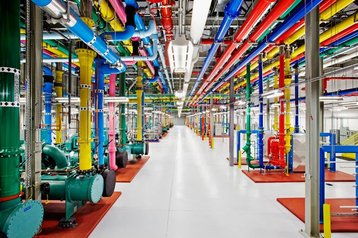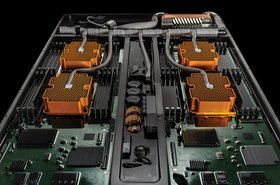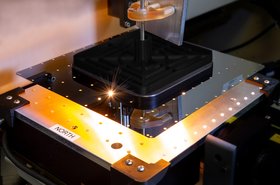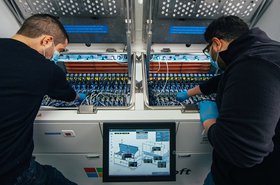Today, artificial intelligence can be found all around the data center – helping manage and protect the network, filtering alerts, and moving workloads. However, the industry has been slow to apply AI to the problems of operational technology, rather than IT. And specifically, to the realm of cooling, sometimes responsible for as much as a third of the overall power consumption of a server farm.
You have likely heard the story about Google using a deep learning-based recommendation engine developed by DeepMind to “consistently” reduce the amount of energy used for cooling in one of its data centers by 40 percent. In 2018, the company went a step further and allowed the algorithms to make adjustments automatically, under human supervision.
Given the industry’s concern over emissions, and its enthusiasm for AI, one might have hoped that this development would now be in more widespread use by now.
This article appeared in Issue 39 of the DCD>Magazine. Subscribe for free today
A slow start
Unfortunately, the creation of such systems requires a combination of deep technical expertise in data centers, and cutting-edge machine learning research; we have to remember that DeepMind is a ‘moonshot factory’ with a seemingly unlimited budget and no commercial products.
Since data centers represent the core of Google’s business, the company is unlikely to share whatever it has developed with the industry. It is up to established data center software vendors to introduce machine learning into white space management.
The process has been slow, hampered by general distrust in AI tech, but in the past two years, promising case studies have been coming to light, outside Google as well as within. Data center operators are reporting that AI does indeed reduce the amount of energy they spend on cooling, shrinking their energy bills and their carbon footprint.
Real-time control of cooling equipment presents a fitting problem for machine learning models, since they can consider much more data in their decisions than human teams possibly could, and can produce solutions that might seem unconventional and even counter-intuitive. There’s plenty of data to feed the models: unlike some other industrial environments, data centers are already chock-full of sensors, and can easily add more.
At the end of 2020, German industrial giant Siemens published a whitepaper in which it highlighted some of the benefits of AI-based cooling in action. It said machine learning enabled cooling systems to adjust their output in real-time to match facility cooling needs to the cooling output as IT loads change.
That’s a worthy goal, as it directly cuts energy use by avoiding the issue of overcooling – which is widespread in data centers. This industry loves to err on the side of caution.
AI for cooling also minimizes the need for staff supervision and personnel on site, allowing employees to be assigned to other critical tasks and reducing the number of people who need to visit, which is important in a pandemic when site access is limited.
Siemens’ own approach to AI for cooling combines two products: Demand Flow, which focuses on monitoring and control of chilled water delivery, and something called White Space Cooling Optimization (WSCO) – a platform that collects temperature and air supply sensor data and calculates the required adjustments in airflow to maintain the correct temperature for each aisle of racks.
In December, the platform was deployed to supervise cooling at the first Tier IV-certified data center in Paris, built for French state-owned bank Caisse des Dépôts. The facility is expected to operate at a power usage effectiveness (PUE) of 1.2.
Siemens’ WSCO was developed in partnership with a fascinating company called Vigilent (formerly Federspiel Controls), a tiny Oakland-based firm specializes in one thing, and one thing only - mission-critical cooling.
Vigilent has developed (and patented) a dynamic cooling management system powered by supervised learning that can take control of equipment, just like the system developed by DeepMind.
The software learns by continuously analyzing sensor data for environmental changes, basing its recommendations on historic behavior. It can establish the contribution of every single CRAH unit in the building, and point out the ones that are wasting their cooling efforts.
Vigilent promises similar levels of energy savings to those seen in the Google experiment, claiming an average 38 percent reduction in power spent on cooling across more than 500 installations. The company supplies machine learning tech to not just Siemens, but a plethora of DCIM and BMS software vendors like ABB, Hitachi Vantara. and Schneider Electric.
Another business leading the charge on AI for automated cooling management is Chinese conglomerate Huawei. Last year, the company launched iCooling, a cloud-based service that uses deep learning to process sensor data, find the relationships between parameters of different pieces of equipment and systems, and match the output of pumps, chillers and cooling towers to the IT load.
The company claimed that the service improved power usage effectiveness (PUE) by eight percent when deployed at one of its own cloud data centers. When China Mobile trialed iCooling, it shaved off 3.2 percent of the overall power consumption of its facility in Zhongwei, or over 400,000 kWh. The system is expected to produce even greater energy savings as it continues to learn from data.
The conversation about AI for data center cooling ties into the wider debate around AI for sustainability: a recent report from Capgemini Research estimated that innovative applications of artificial intelligence could reduce global greenhouse gas emissions by 16 percent within the next three to five years
Capgemini identified a number of positive AI use cases within the report, and noted that energy optimization platforms and algorithms to identify defects and predict equipment failures without interrupting business operations are among those that are set to make the biggest impact.
Following the success of AI deployments in other industries, AI for cooling and other elements of data center infrastructure management is the next big thing - it’s just a matter of turning theory into practice.
“AI promises to reshape data center operations in the coming years,” Siemens warned in its whitepaper. “However, data centers need to prepare today to be relevant tomorrow.”





